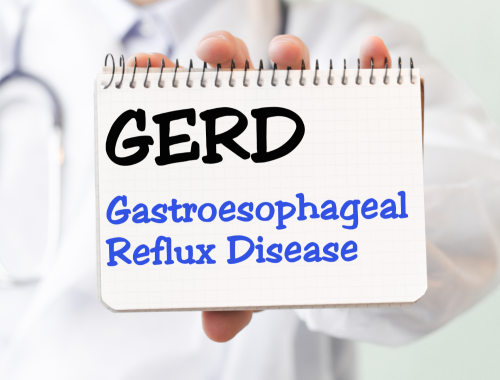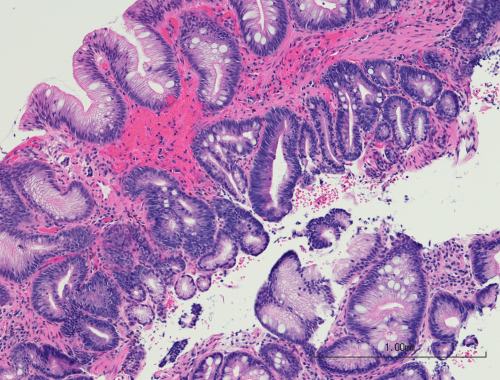Difference Between Barrett’s Esophagus and GERD
• Categorized under Disease,Health,Science | Difference Between Barrett’s Esophagus and GERD
Gastroesophageal reflux disease (GERD) is chronic acid reflux from the stomach to the esophagus. Barrett’s esophagus is a condition in which the normal epithelial lining of the lower esophagus is replaced by the intestinal epithelium.

What is GERD?
Definition:
Gastroesophageal reflux disease (GERD) is chronic acid reflux from the stomach to the esophagus.
Symptoms:
Symptoms of GERD include dyspepsia, heartburn, chest pain, sour taste in the mouth, dental erosions, asthma symptoms, and dysphagia.
Risk factors:
People with the following conditions are more at risk of developing GERD. These include obesity, smoking, hiatal hernia, pregnancy, connective tissue disorders, and delayed gastric emptying. Aggravating factors of gastric reflux are eating large fatty meals, eating late at night, chronic alcohol and caffeine intake, and regularly taking over-the-counter medications such as aspirin.
Diagnosis:
The diagnosis of GERD is made by digging into the medical history of the patient. Rarely, radiologic investigations are needed to visualize the esophagus.
Treatment:
Antacids and proton pump inhibitors such as Omeprazole, and esomeprazole are the mainstay drugs for treating GERD. Histamine (H2) blockers such as Cimetidine as also important to slow down the disease progression. If medications are futile then surgical options such as Nissen fundoplication might be decided for.
Prevention:
GERD can be prevented by incorporating the following tips: maintaining a healthy weight, avoiding smoking, avoiding large, fatty meals, especially before bedtime, not lying down for at least an hour after eating a heavy meal, and exercising.

What is Barrett’s esophagus?
Definition:
Barrett’s esophagus is a condition in which the normal epithelial lining of the lower third of the esophagus is replaced by the intestinal epithelium.
Symptoms:
Symptoms of Barrett’s esophagus include severe heartburn, dysphagia, dyspepsia, the sensation of food sticking in the esophagus, halitosis, sore throat, weight loss, and nausea.
Cause:
Chronic GERD is the main cause of Barrett’s esophagus.
Diagnosis:
The diagnosis of Barrett’s esophagus is made via upper gastrointestinal endoscopy and biopsy. The biopsy shows classic intestinal metaplasia in the esophageal epithelium.
Treatment:
Initially, medications such as proton pump inhibitors, histamine receptor blockers, and antacids are given to reduce chronic reflux. Treatment options for Barrett’s esophagus include radiofrequency ablation, cryotherapy, endoscopic mucosal resection, and esophagectomy.
Prevention:
Barrett’s esophagus can be prevented by preventing chronic reflux. Chronic heartburn should be treated, alcohol and smoking should be avoided, and a healthy weight should be maintained.
Difference between Barrett’s esophagus and GERD
Definition:
Gastroesophageal reflux disease (GERD) is chronic acid reflux from the stomach to the esophagus. Barrett’s esophagus is a condition in which the normal epithelial lining of the lower third of the esophagus is replaced by the intestinal epithelium.
Symptoms:
Symptoms of GERD include dyspepsia, heartburn, chest pain, sour taste in the mouth, dental erosions, asthma symptoms, and dysphagia. Symptoms of Barrett’s esophagus include severe heartburn, dysphagia, dyspepsia, the sensation of food sticking in the esophagus, halitosis, sore throat, weight loss, and nausea.
Diagnosis:
The diagnosis of GERD is made by digging into the medical history of the patient. Rarely, radiologic investigations are needed to visualize the esophagus. The diagnosis of Barrett’s esophagus is made via upper gastrointestinal endoscopy and biopsy. The biopsy shows classic intestinal metaplasia in the esophageal epithelium.
Treatment:
Antacids and proton pump inhibitors such as Omeprazole, and esomeprazole are the mainstay drugs for treating GERD. Histamine (H2) blockers such as Cimetidine as also important to slow down the disease progression. If medications are futile then surgical options such as Nissen fundoplication might be decided for. Treatment options for Barrett’s esophagus include radiofrequency ablation, cryotherapy, endoscopic mucosal resection, and esophagectomy.
Prevention:
GERD can be prevented by incorporating the following tips: maintaining a healthy weight, avoiding smoking, avoiding large, fatty meals, especially before bedtime, not lying down for at least an hour after eating a heavy meal, and exercising. Barrett’s esophagus can be prevented by preventing chronic reflux. Chronic heartburn should be treated, alcohol and smoking should be avoided, and a healthy weight should be maintained.
Table of difference between Barrett’s esophagus and GERD

FAQs
Can GERD lead to Barrett’s esophagus?
Yes, chronic GERD is the main cause of Barrett’s esophagus
Are there any risk factors for developing Barrett’s esophagus or GERD?
Obesity, smoking, hiatal hernia, pregnancy, connective tissue disorders, and delayed gastric emptying are risk factors for developing GERD and Barrett’s esophagus.
How are Barrett’s esophagus and GERD treated differently?
GERD is treated with medications like proton pump inhibitors, antacids, and histamine receptor blockers whereas Barrett’s esophagus is treated with endoscopic resection or surgery.
Is it possible to have Barrett’s esophagus without having GERD?
Yes.
What are the long-term consequences of Barrett’s esophagus and GERD?
Long-term GERD causes Barrett’s esophagus. Long-term Barrett’s esophagus leads to esophageal carcinoma.
Can lifestyle changes help prevent or manage Barrett’s esophagus and GERD?
Yes. Chronic heartburn should be treated, alcohol and smoking should be avoided, and a healthy weight should be maintained to prevent these conditions.
- Differences Between Reptiles and Amphibians - May 17, 2024
- Difference Between Ophthalmology and Optometry - May 15, 2024
- Difference Between Fear and Anxiety - April 2, 2024
Sharing is caring!
Search DifferenceBetween.net :
Cite
APA 7
Maab, D. (2023, June 25). Difference Between Barrett’s Esophagus and GERD. Difference Between Similar Terms and Objects. https://www.differencebetween.net/science/health/difference-between-barretts-esophagus-and-gerd/.
MLA 8
Maab, Dr. Hiraa. "Difference Between Barrett’s Esophagus and GERD." Difference Between Similar Terms and Objects, 25 June, 2023, https://www.differencebetween.net/science/health/difference-between-barretts-esophagus-and-gerd/.
Leave a Response
Written by : Dr. Hiraa Maab. and updated on 2023, June 25
References :
[0]Clarrett, Danisa M., and Christine Hachem. "Gastroesophageal reflux disease (GERD)." Missouri medicine 115.3 (2018): 214.
[1]Badillo, Raul, and Dawn Francis. "Diagnosis and treatment of gastroesophageal reflux disease." World journal of gastrointestinal pharmacology and therapeutics 5.3 (2014): 105.
[2]Spechler, Stuart Jon, and Raj K. Goyal. "Barrett's esophagus." New England Journal of Medicine 315.6 (1986): 362-371.
See more about : Barrett's Esophagus, GERD
